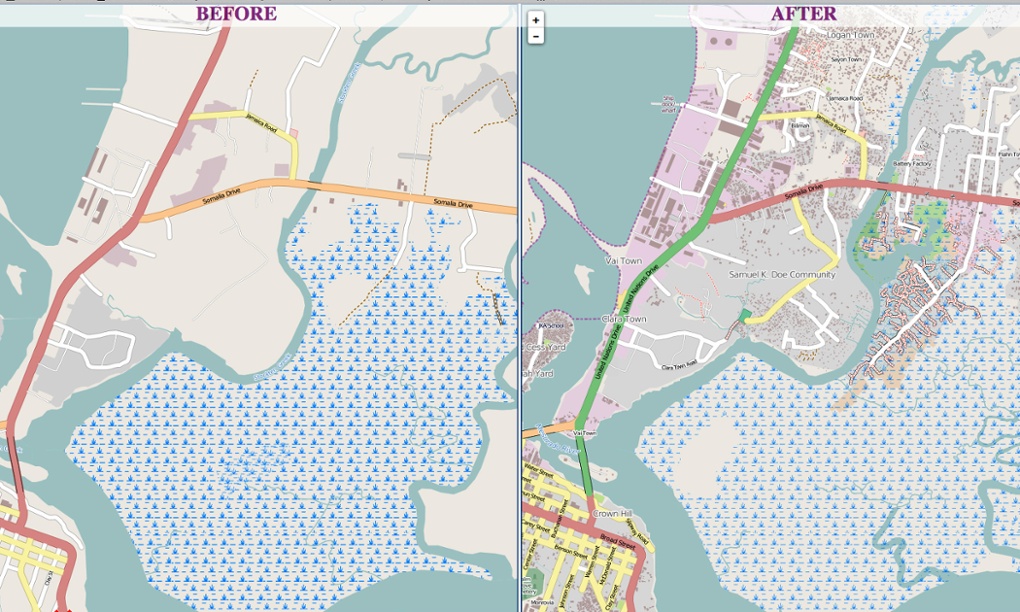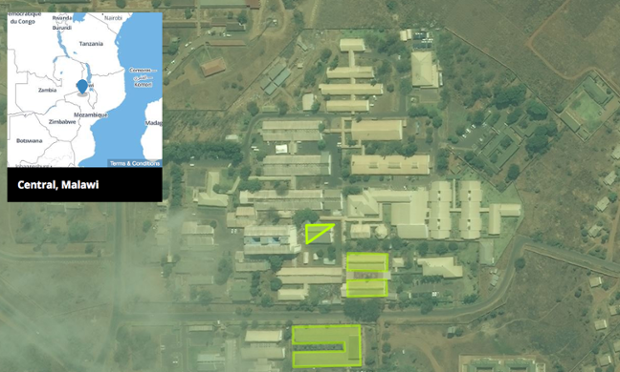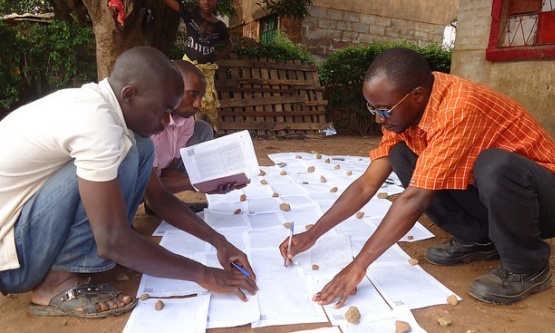A huge number of the world’s most vulnerable human settlements have remained unmapped … until now. Enter an unprecedented plan to map the world’s forgotten places.
In 2010, an earthquake struck Haiti. Hundreds of thousands were killed. Then things got really bad. Cholera broke out, and Ivan Gayton of Médecins Sans Frontières received a call from a nun, in a remote village in the middle of the Haitian forest. “Please help,” she said. “We’ve been hit with a horrible disease we’ve never seen before.”

Gayton sent a few trucks of MSF staff to try to track down the nun in Baradères. They had only the sketchiest maps. Every village they reached, they thought: “This must be it – they’re dropping like flies here.” But it wasn’t. They left behind equipment and staff, and kept driving, leaving huge numbers of sick people behind to die. The road ran out. They took a boat up the coast. Eventually they arrived at a dock, “piled with corpses like firewood”, Gayton says. This was the nun’s village. The MSF staff did what they could. Over the next few days more than 600 deathly ill people arrived. MSF saved most of them; nearly half would likely have died.
[infobox]… cholera and other diseases continue to overrun the world. Part of the reason? A lack of basic maps.[/infobox]Across Haiti, only 0.9% of people treated in MSF clinics succumbed to cholera, compared to 40% of untreated cases across the country; the charity spent $100m (£62m) and saved countless lives. Thousands of Haitians died anyway. Gayton describes the choice of locations to establish clinics as “war triage” decisions. “In triage, some people are badly wounded, others nearly dead. We have to treat the people in the middle to maximise the number of lives saved. We can’t help everyone,” he says. “In Haiti, entire communities and areas were left to die. We got a call like the one from the nun once a week. That’s one of the only ones we responded to. I’m convinced we missed a huge number of people.”
From our partners:
Part of MSF’s problem was that it was so difficult to know whether sending people to Baradères was the best use of resources. “Haiti was this gigantic emergency intervention, and at MSF we’d committed ourselves to be the ones who respond – but we couldn’t do it all,” he says. “So I became quite keen to know exactly where the greatest needs were: the greatest impact for the greatest number.”
Location, location, location – it has been the founding myth of epidemiology since John Snow took addresses from cholera victims, put them on a map of London, traced the cholera outbreak to Soho and turned off the contaminated pump. And yet a century and a half after Snow’s breakthrough, cholera and other diseases continue to overrun the world. Part of the reason? A lack of basic maps.
A surprisingly large number of the world’s cities remain unmapped. Nobody knows exactly how many, but cities of more than a million people in the developing world get by every day without an accurate map. Development staff in those cities trade photocopies of photocopies, scrawl the names of landmarks on post-it notes, use satellite images that lack street names, or just ask locals.
In the west, we take for granted that Google has mapped every street in every city – but when MSF asks patients where they’re from, they often have no idea what the answer they receive even means. Bobere: is that a village, street, neighbourhood, ward, district, province? “Much of the time it may as well be random syllables,” Gayton says. “If there was a point source for cholera in Haiti, we wouldn’t have known where it was. We needed a map – to be able to correlate the alerts we hear and our patient origins to something on the ground.”

It wouldn’t just be useful in Haiti, MSF began to realise. After all, why wait until crises happen? If humanitarian agencies had good digital maps now of places that are particularly prone to natural disasters, conflict or epidemic diseases, they’d be ahead of the curve, and could respond properly as soon as a crisis occurs. But how?
The ingenious solution is the Missing Maps project, which will be a collaboration by MSF, the American and British Red Cross, the Humanitarian OpenStreetMap Team and others to create free, digital maps for every single settlement on Earth. It is nothing less than a human genome project for the world’s cities.
The method, developed by the Humanitarian OpenStreetMap Team, is deceptively simple – and crucially, it allows volunteers to take part remotely.

- The first step is to take satellite images – which, it may surprise you to learn, are often made available to the open mapping community from such unexpected sources as US government agencies and Microsoft – and plug them into the free mapping software OpenStreetMap.
- Volunteers then log in remotely, from anywhere in the world, and use a easy point-and-click tool to literally trace the outlines of buildings, roads, parks and rivers over the satellite image. Remove the image and voila: you have a basic, digital city map.
- Next, the map, which still lacks street or landmark names, is physically printed out and posted to volunteers who are located in the city. These “ground troops” – anyone from students to Scouts – each take a small section of the map, head out with a pencil and write down the names of streets and buildings.
- Finally, the completed maps are posted back to Missing Maps HQ in London, where volunteers fill in the names on OpenStreetMap. The result: a city map that is open source and free for ever.

The first big test case was Lubumbashi, a city in the Democratic Republic of Congo whose 1.5 million residents lacked something as basic as an online street map – until now. Missing Maps aims to map the rest of the world’s poorest and most vulnerable urban areas within two years. And because the first and last mapping phases can be done by anyone with a laptop, anywhere, the whole thing can be crowdsourced.
“Finally, I can give volunteers something to do that isn’t just giving money,” Gayton says. “Many people want to help MSF, hands on, not just donating. They offer to knit socks for the kiddies and so on. But I tell them no, don’t knit socks for the kiddies – the cost of gettting those socks out there and distributing them just isn’t worth the potential benefit. But with Missing Maps, they can actually participate in real, genuine fieldwork. That’s huge.”
Crowdsourcing also gives the open-source project an advantage over Google Maps, which is engaged in its own effort to build proprietary maps for cities in Africa and the developing world. By harnessing the aggregated individual acts volunteered by everyday people, Missing Maps can make its scope truly planetary. Google has similarly been asking people to voluntarily flesh out Google Maps, following criticism that the company was ignoring places where there was no advertising money to be made. After all, there’s no Starbucks in a slum. And Google Maps is, like the rest of Google’s projects (whatever their current openness and freedom of use), privately owned and subject to fees at any time they might choose to start charging.
[infobox]”When you think about it, maps are a very basic fundamental knowledge tool, woven into our urban environment, and silently improving our lives in all sorts of ways.”[/infobox]“The point of the project is that the maps will all be open source,” says Missing Maps coordinator Pete Masters. “It will be illegal for anyone to charge anyone to use them – meaning local people will have total access to them, not just to look at, but to edit and develop.”
That idea more than any other has fired the imaginations of the people in unmapped places, says Gayton. “It’s legally impossible for someone to steal it, to close off and own the data. It’s created by genuine volunteer labour, and belongs to everyone. And the question everyone asks me is: ‘Why?’ They couldn’t believe it.”

The project has actually already begun: MSF and the Red Cross have already begun recruiting new volunteers to join the Humanitarian OpenStreetMap Team, teaching them how to map settlements where Ebola has broken out. Ultimately the Missing Maps project will need to recruit the biggest team of digital humanitarian volunteers ever conceived.
[infobox]Just as the human genome project simply recorded genes, with scientists subsequently using that data to study disease and create new medicines, so too are city maps just the building blocks for urban planning.[/infobox]But the implications of a digital map of all human settlements are by no means only about epidemiology. The possible applications for urbanism – transit planning, waste removal, housing strategy – are vast.
“Maps make us think of things like finding a restaurant on the web or navigating with a satnav,” says Harry Wood, a member of the Humanitarian OpenStreetMap Team board. “But somebody also used a map for deciding which road the bus route should go down, and deciding where the road should be in the first place. When you think about it, maps are a very basic fundamental knowledge tool, woven into our urban environment, and silently improving our lives in all sorts of ways.”
[infobox]Missing Maps is a crucial first step. For much of the developing world, our current digital maps may as well say ‘Here there be dragons.’ There’s a long way to go, but someone has at last picked up a sword.[/infobox]So it’s not just about fighting Ebola and cholera – though that is crucial, Wood says. “When the Ebola epidemic passes, OpenStreetMap will remain as an information resource silently and indirectly helping with urban planning and economic growth in these countries.”
Just as the human genome project simply recorded genes, with scientists subsequently using that data to study disease and create new medicines, so too are city maps just the building blocks for urban planning. Whether the goal is to prevent cholera or crime, Missing Maps is a crucial first step. For much of the developing world, our current digital maps may as well say ‘Here there be dragons.’ There’s a long way to go, but someone has at last picked up a sword.
This article originally appeared in The Guardian.















